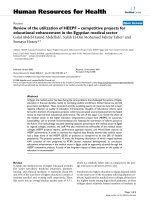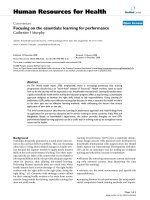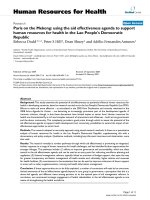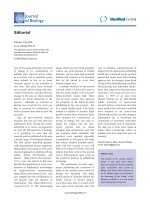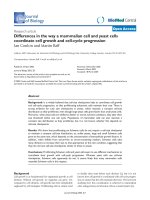Báo cáo sinh học: "Scribble at the crossroads" pptx
Bạn đang xem bản rút gọn của tài liệu. Xem và tải ngay bản đầy đủ của tài liệu tại đây (95.31 KB, 3 trang )
Etienne-Manneville: Journal of Biology 2009, 8:104
Abstract
Although proteins involved in determining apical-basal cell
polarity have been directly linked to tumorigenesis, their precise
roles in this process remain unclear. A recent report in BMC
Biology clarifies the signaling pathways that control cell polarity,
proliferation and apoptosis downstream of the tumor suppressor
and apical-basal polarity determinant Scribble.
See research article />As the signaling networks that control cell polarity are
deciphered, it is clear that some of the main regulators
of epithelial apical-basal polarity are also involved in
tumorigenesis. This is hardly surprising. As loss of
polarity and tissue architecture is a common feature of
carcinomas, we might expect that regulation of cell
polarity would be altered at some stage of tumor
development. But whether loss of cell polarity on its
own is sufficient for tumor formation is debatable. A
more general question is whether polarity proteins
contribute to tumorigenesis directly through disruption
of their polarizing functions, or whether their
involvement in tumorigenesis is due to their roles in the
signaling pathways that independently control cell
division, cell apoptosis and cell polarity?
In Drosophila, the genes scribble (Scrib in mammals),
discs large (Dlg) and lethal giant larvae (Lgl) act
together to regulate epithelial cell apico-basal polarity
and also act as tumor suppressor genes [1]. Scribble
encodes a multidomain scaffold protein of the LAP
(LRR and PDZ) family and is therefore likely to be
involved in several distinct signaling pathways. A single
mutation in scribble can induce loss of apical-basal
polarity and massive hyperproliferation of the imaginal
discs, demonstrating a role for Scribble in the regulation
of both polarity and cell proliferation. In a recent paper
in BMC Biology, Anthony Brumby and colleagues
(Leong et al. [2]) provide further insights into the role
of polarity proteins in tumorigenesis. They have
characterized two distinct signaling pathways
downstream of Scribble in Drosophila, one of which
controls both cell polarity and cell proliferation,
whereas the other leads to apoptosis.
Polarity proteins and cancer
In Drosophila, homozygous scribble mutant clones in an
otherwise heterozygous animal develop relatively few
tumors, which are eliminated by apoptosis, and simul-
taneous oncogenic mutations involving Ras or Notch are
required to promote hyperproliferation and metastasis [3].
In humans, a correlation between reduced Scrib expression
and malignant progression has been reported in colon
cancer [4]. In addition, Scrib is targeted for ubiquitin-
mediated degradation by high-risk human papillomavirus
(HPV) E6 proteins [5], suggesting that Scrib degradation
contributes to the development of HPV-induced cervical
carcinoma. However, as in Drosophila, it seems that
additional oncogenic mutations are needed to drive
tumori genesis in humans [6,7].
In addition to Scrib, Lgl and Dlg, several other major
regulators of cell polarity have been shown to be involved
in cancer progression [8]. In particular, the atypical
protein kinase C (aPKC) PKCι may function as an onco-
protein in humans, as high levels of aPKC lead to both cell
hyper proliferation and loss of epithelial apical-basal
polarity [9] (Figure 1). This raises the question of how
polarity proteins are linked to the regulation of cell
proliferation and tumori genesis and whether this
relation ship involves the signaling pathways that control
cell polarity?
Polarity and cell proliferation
The original genetic studies performed in Drosophila
showed that Scribble functions in a complex with Dlg
and Lgl to promote basolateral membrane identity. Two
other protein complexes - the Bazooka (Par3 in
mammals) complex, which also includes Par6 and aPKC,
and the Crumbs complex of Crumbs, Stardust and Patj -
define the apical surface (see [1] and references therein).
The relationship between these three complexes lies at
the heart of epithelial cell polarity. aPKC seems to be a
critical linking factor, as it mediates the phosphorylation
of both Par3 and Crumbs to control their apical
localization. Conversely, the Crumbs complex activates
aPKC and prevents the Scribble complex forming in the
apical part of the cell. The mechanism underlying this
remains obscure, but it might be due to phosphorylation
Minireview
Scribble at the crossroads
Sandrine Etienne-Manneville
Address: Institut Pasteur, Cell Polarity and Migration Group and CNRS URA 2582, 25 rue du Dr Roux, 75724 Paris cedex 15, France.
Email:
104.2
Etienne-Manneville: Journal of Biology 2009, 8:104
of Lg1 by aPKC. Reciprocally, Scribble has also been
shown to act upstream of aPKC to dictate cell polarity in
the directed migration of mammalian astrocytes and
epithelial cells [10,11].
The antagonism between aPKC and the Scribble complex
in the regulation of cell polarity is reflected by the
opposing effects of aPKC and Scribble in tumor
development. Whereas scribble acts as a tumor
suppressor gene, oncogenic functions have been
attributed to PKCι in humans [9]. Leong et al. [2] now
show that in Drosophila, overexpression of a membrane-
targeted aPKC mimics the scribble mutant phenotype.
Normal cell morphology was obtained when a dominant-
negative aPKC was expressed in scribble mutant cells.
This aPKC function does not involve regulation of the
Crumbs complex, as a null mutation in Crumbs did not
compensate for the effects of the scribble mutations on
cell polarity and proliferation [2]. This study clearly
highlights the role of aPKC in mediating Scribble function
in both polarity and cell proliferation and it is tempting to
speculate that aPKC is also involved in overgrowth and in
the polarity defects observed in wing discs following
Crumbs overexpression. Their results suggest that the
functions of Scribble in cell polarity and cell proliferation
cannot be separated.
Polarity and overgrowth
In the absence of additional oncogenic mutations, scribble
mutant clones display defects in cell polarity and show
increased cell proliferation but do not overgrow. Growth
control results from the regulation of both cell proliferation
and apoptosis (Figure 1). In Drosophila, signaling via the
fly version of the mammalian Jun-N-terminal kinase
(JNK) pathway induces apoptosis, which eliminates
develop mentally aberrant cells from a tissue [12]. In line
with this, JNK is activated in the scribble mutant cells
investigated by Leong et al. and limits tumor growth by
promoting apoptosis [2,3].
Interestingly, the Par6-aPKC polarity complex can inhibit
apoptosis in polarized mammalian epithelial cells in
culture [13], and conversely, pro-apoptotic JNK is also a
major component of the WNT-regulated planar cell
polarity pathway in mammals, suggesting that polarity and
apoptosis may use common signaling pathways (Figure 1).
However, in Drosophila, Leong et al. [2] find that
inhibition of aPKC does not prevent JNK-mediated cell
death of scribble mutant cells, and that expression of
dominant-negative JNK does not rescue the effects of
scribble mutations on cell proliferation and polarity. Thus,
cell proliferation and polarity on the one hand, and
apoptosis on the other, are controlled by two distinct
Figure 1
Complex interplay between oncogenic pathways. Changes in tumor malignancy from hyperplasia to metastatic cancer result from the
accumulation of numerous alterations of normal cellular functions. Cell polarity, cell proliferation and apoptosis are key targets of neoplastic
mutations. Proteins such as Scribble, aPKC or JNK (see text) can simultaneously participate in several signaling pathways (dotted arrows)
controlling these different cell functions. Consequently, changes in their activity are likely to have dramatic effects on tumor progression. In
the case of Scribble, mutations lead to loss of cell polarity, to increased cell proliferation and to the induction of pro-apoptotic pathways via a
subset of these intertwined signaling cascades (highlighted in red).
Polarity defect
Apoptosis
Proliferation
Overgrowth
Hyperplasia
Neoplasia
Metastatic cancer
Migration
Invasion
Scribble
aPKC
JNK
Mutations
104.3
Etienne-Manneville: Journal of Biology 2009, 8:104
signaling pathways downstream of Scribble (Figure 1). The
relationship of Scribble to the JNK-dependent pro-
apoptotic pathway is likely to be indirect; this pathway may
be triggered by altered cell-cell junctions or tissue
disorganization and may also involve autocrine or
paracrine stimulation of cells by the cytokine tumor
necrosis factor.
One puzzling observation from this and other studies in
Drosophila is that although JNK is pro-apoptotic, it is also
required for the neoplastic overgrowth observed in scribble
mutants expressing the additional oncogenic signals
induced by mutant Ras, Notch, Stardust or Crumbs [2,14].
Whether these oncogenic signals modulate JNK activation
levels and alter its function, or whether they control other
transcriptional regulators that may divert JNK signals,
remains unclear. In mammals, two JNK proteins (JNK1
and JNK2) are expressed, and they seem to have opposing
tumor-suppressive and tumor-promoting activities [15].
The observations in Drosophila may therefore reflect a
limitation of this model system, in which a single JNK can
both restrain and enable overgrowth.
Loss of polarity and tumorigenesis
The study by Leong et al. [2] indicates that the effects of
Scribble on cell polarity and cell proliferation in Drosophila
involve the same aPKC-dependent and JNK-independent
pathway, and it is not yet possible to distinguish separate
mechanisms regulating cell polarity and proliferation. In
humans, the protein kinase LKB1 acts as a polarity protein
and a tumor suppressor. Causal mutations in the carboxy-
terminal domain of LKB1 in people with the cancer-prone
Peutz-Jeghers syndrome do not affect cell proliferation but
strongly alter cell polarity [16], suggesting that polarity and
proliferation result from distinct pathways. Loss of polarity
in epithelial cells is, however, bound to alter their response
to mitogenic signals. Could loss of polarity be a first step
towards overproliferation and tumorigenesis? The intimate
link between cell polarity and cell proliferation remains
unclear, and further investigation of the signaling path-
ways controlling these two essential properties of
functional epithelial tissues should lead to a better
understanding of the multiple steps leading to cancer.
References
1. Bilder D: Epithelial polarity and proliferation control: links
from the Drosophila neoplastic tumor suppressors. Genes
Dev 2004, 18:1909-1925.
2. Leong GR, Goulding KR, Amin N, Richardson HE, Brumby AM:
scribble mutants promote aPKC and JNK-dependent epi-
thelial neoplasia independently of Crumbs. BMC Biol 2009,
7: 62.
3. Brumby AM, Richardson HE: scribble mutants cooperate
with oncogenic Ras or Notch to cause neoplastic over-
growth in Drosophila. EMBO J 2003, 22:5769-5779.
4. Gardiol D, Zacchi A, Petrera F, Stanta G, Banks L: Human
discs large and scrib are localized at the same regions in
colon mucosa and changes in their expression patterns
are correlated with loss of tissue architecture during
malignant progression. Int J Cancer 2006, 119:1285-1290.
5. Thomas M, Massimi P, Navarro C, Borg JP, Banks L: The
hScrib/Dlg apico-basal control complex is differentially tar-
geted by HPV-16 and HPV-18 E6 proteins. Oncogene 2005,
24: 6222-6230.
6. Dow LE, Elsum IA, King CL, Kinross KM, Richardson HE,
Humbert PO: Loss of human Scribble cooperates with
H-Ras to promote cell invasion through deregulation of
MAPK signalling. Oncogene 2008, 27:5988-6001.
7. Zhan L, Rosenberg A, Bergami KC, Yu M, Xuan Z, Jaffe AB,
Allred C, Muthuswamy SK: Deregulation of scribble pro-
motes mammary tumorigenesis and reveals a role for cell
polarity in carcinoma. Cell 2008, 135:865-878.
8. Wodarz A, Nathke I: Cell polarity in development and
cancer. Nat Cell Biol 2007, 9:1016-1024.
9. Eder AM, Sui X, Rosen DG, Nolden LK, Cheng KW, Lahad JP,
Kango-Singh M, Lu KH, Warneke CL, Atkinson EN, Bedrosian
I, Keyomarsi K, Kuo WL,Gray JW, Yin JC, Liu J, Halder G, Mills
GB: Atypical PKCiota contributes to poor prognosis
through loss of apical-basal polarity and cyclin E overex-
pression in ovarian cancer. Proc Natl Acad Sci USA 2005,
102: 12519-12524.
10. Osmani N, Vitale N, Borg JP, Etienne-Manneville S: Scrib con-
trols Cdc42 localization and activity to promote cell polari-
zation during astrocyte migration. Curr Biol 2006, 16:
2395-2405.
11. Dow LE, Kauffman JS, Caddy J, Peterson AS, Jane SMR,
Russell SM, Humbert PO: The tumour-suppressor Scribble
dictates cell polarity during directed epithelial migration:
regulation of Rho GTPase recruitment to the leading edge.
Oncogene 2007, 26:2272-2282.
12. Igaki T: Correcting developmental errors by apoptosis:
lessons from Drosophila JNK signaling. Apoptosis 2009,
14: 1021-1028.
13. Kim M, Datta A, Brakeman P, Yu W, Mostov KE: Polarity pro-
teins PAR6 and aPKC regulate cell death through GSK-
3beta in 3D epithelial morphogenesis. J Cell Sci 2007, 120:
2309-2317.
14. Uhlirova M, Jasper H, Bohmann D: Non-cell-autonomous
induction of tissue overgrowth by JNK/Ras cooperation in
a Drosophila tumor model. Proc Natl Acad Sci USA 2005,
102:
13123-13128.
15. Wagner EF, Nebreda AR: Signal integration by JNK and p38
MAPK pathways in cancer development. Nat Rev Cancer
2009, 9:537-549.
16. Forcet C, Etienne-Manneville S, Gaude H, Fournier L, Debilly
S, Salmi M, Baas A, Olschwang S, Clevers H, Billaud M:
Functional analysis of Peutz-Jeghers mutations reveals
that the LKB1 C-terminal region exerts a crucial role in reg-
ulating both the AMPK pathway and the cell polarity. Hum
Mol Genet 2005, 14:1283-1292.
Published: 29 December 2009
doi:10.1186/jbiol190
© 2009 BioMed Central Ltd

